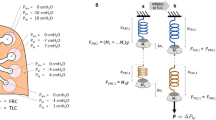Abstract
A mathematical model of chest wall mechanics, based on a phenomenological approach to force balances, provides a quantitative framework for analyzing many types of chest wall movements by using orthogonal displacement coordinates. The moveable components of the ventilatory system include the rib cage, diaphragm, and abdomen. A distinction is made between the lung-apposed and diaphragm-apposed actions on the rib cage. The model equations are derived from “pressure” balances and geometrical relations of the compartments; the stress-displacement relations are hyperbolic. With this model we simulated stiff and flaccid chest wall behavior under normal and constrained conditions associated with abdominal compression, a Mueller maneuver, and a diaphragmatic isometric inspiration. We also examined situations that produce paradoxical as well as orthodox inspiratory movements. The results of these simulations were quantitatively consistent with available data from the literature. A phenomenon predicted by the stiff-wall model during quasi-static inspiration is that the rib cage displacement is negligible near residual volume, but then increases dramatically with lung volume. Since this mathematical model has a sound physical basis and is more comprehensive than previous models, it can be used to predict and analyze the behavior of the chest wall under a wide variety of circumstances.
Similar content being viewed by others
References
Agostoni, E.; Mognoni, P.; Torri, G.; Saracino, F. Relation between changes of rib cage circumference and lung volume. J. Appl. Physiol. 20:1179–1186; 1965.
DeTroyer, A.; Heilporn, A. Respiratory mechanics in quadriplegia. The respiratory function of the intercostal muscles. Am. Rev. Respir. Dis. 122:591–600; 1980.
Derenne, J.P.; Macklem, P.T.; Roussos, C.H. The respiratory muscles: mechanics, control, and pathophysiology. Am. Rev. Respir. Dis. 118:119–133; 1978.
Goldman, M.D.; Mead, J. Mechanical interaction between the diaphragm and rib cage. J. Appl. Physiol. 35:197–204; 1973.
Goldman, M.D. Mechanical interaction between diaphragm and rib cage. Boston view. Am. Rev. Respir. Dis. 119:23–26; 1979a.
Grassino, A.; Goldman, M.D.; Mead, J.; Sears, T.A. Mechanics of the human diaphragm during voluntary contraction: statics. J. Appl. Physiol. Respirat. Environ. Exercise Physiol. 44:829–839; 1978.
Grimby, G.; Goldman, M.; Mead, J. Respiratory muscle action inferred from rib cage and abdominal V-P partitioning. J. Appl. Physiol. 41:739–751; 1976.
Heaf, P.H.D.; Prime, F.J. The compliance of the thorax in normal human subjects. Clin. Sci. 15:319; 1956.
Henderson-Smart, D.J.; Read, D.J.C. Depression of intercostal and abdominal muscle activity and vulnerability to asphyxia during active sleep in the newborn. In Guilleminaults, C.; Dement, W.C., eds. Sleep Apnea Syndromes. New York: A.R. Liss; 1978: pp. 93–117.
Jordanoglou, J. Rib movement in health, kyphoscoliosis and ankylosing spondylitis. Thorax 24:407–414; 1969.
Konno, K.; Mead, J. Measurement of the separate volume changes of rib cage and abdomen during breathing. J. Appl. Physiol. 22:407–422; 1967.
Konno, K.; Mead, J. Static volume-pressure characteristics of the rib cage and abdomen. J. Appl. Physiol. 24:544–548; 1968.
Macklem, P.T.; Gross, D.; Grassino, A.; Roussos, C. Partitioning of inspiratory pressure swings between diaphragm and intercostal/accessory muslces. J. Appl. Physiol. Respirat. Environ. Exercise Physiol. 44:200–208; 1978.
Macklem, P.T. Rib cage diaphragm interaction. Montreal view. Am. Rev. Respir. Dis. 119:27030, 1979.
Macklem, P.T. A mathematical and graphical analysis of inspiratory muscle action. Respir. Physiol. 18:153–171; 1979.
Macklem, P.T. Normal and abnormal function of the diaphragm. Thorax 36:16–163; 1981.
Mead, J. Functional significance of the area of apposition of diaphragm to rib cage. Am. Rev. Respir. Dis. 119, Part 2, Suppl: 31–32; 1979.
Mead, J.; Loring, S.H. Analysis of volume displacement and length changes of the diaphragm during breathing. J. Appl. Physiol. Respirat. Environ. Exercise Physiol. 53:750–755; 1982.
Milic-Emili, J.; Mead, J.; Turner, J.M.; Glauser, E.M. Improved technique for estimating pleural pressure from esophageal balloons. J. Appl. Physiol. 19:207–211; 1964.
Mortola, J.P.; Sant'Ambrogio, G. Motion of the rib cage and the abdomen in tetraplegic patients. Clin. Sci. Mol. Med. 54:25–32; 1978.
Nims, R.G.; Conner, E.H.; Comroe, J.H., Jr. The compliance of the human thorax in anesthetized patients. J. Clin. Invest. 34:744–750; 1950.
Primiano, F.P., Jr. Theoretical analysis of chest well mechanics. J. Biomechanics 15:919–931; 1982.
Rahn, H.; Oti, A.B.; Chadwick, L.E.; Fenn, W.O. The pressure-volume diagram of the thorax and lung. Am. J. Physiol. 146:161–178; 1946.
Sant'Ambrogio, G.; Saibene, F. Contractile properties of the diaphragm in some mammals. Respir. Physiol. 1:349–357; 1970.
Van Lith, P., Johnson, F.N.; Sharp, J.T. Respiratory elastances in relaxed and paralyzed states in normal and abnormal men. J. Appl. Physiol. 23:475–486; 1967.
Author information
Authors and Affiliations
Rights and permissions
About this article
Cite this article
Ben-Haim, S.A., Saidel, G.M. Mathematical model of chest wall mechanics: A phenomenological approach. Ann Biomed Eng 18, 37–56 (1990). https://doi.org/10.1007/BF02368416
Received:
Accepted:
Issue Date:
DOI: https://doi.org/10.1007/BF02368416




